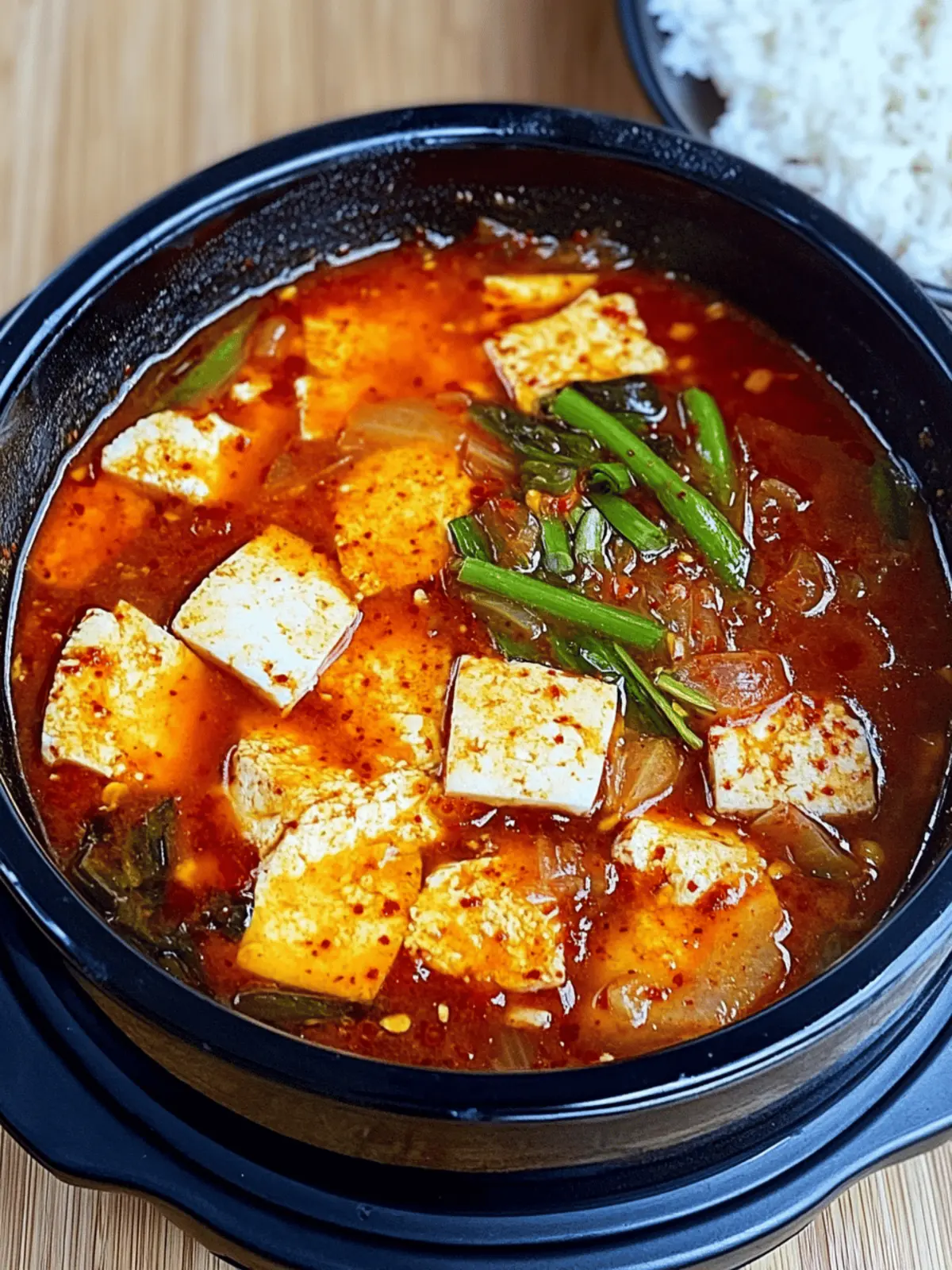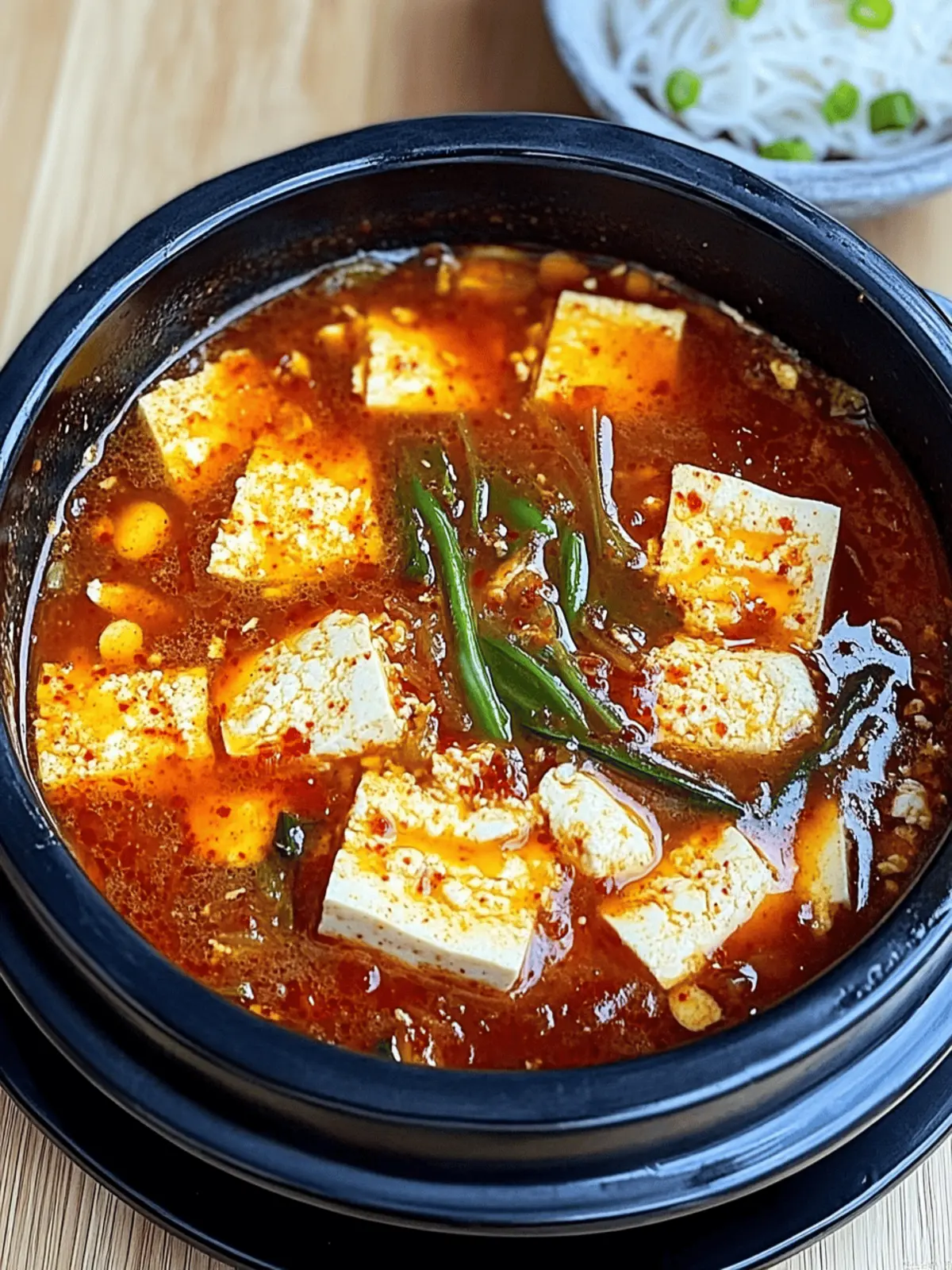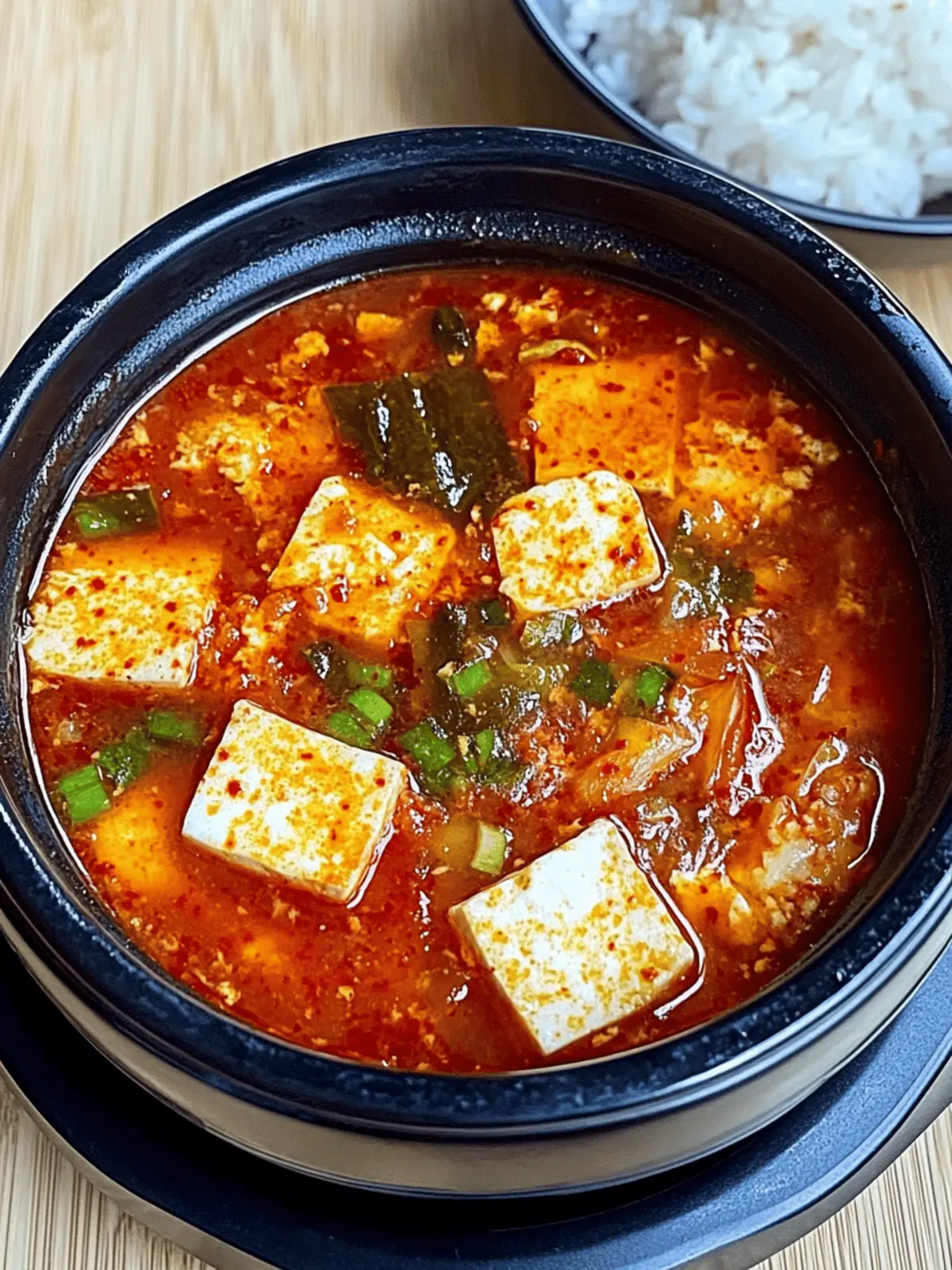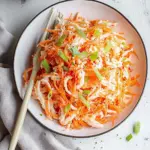There’s nothing quite like the feeling of a warm bowl of Korean Soft Tofu Stew (Sundubu Jjigae) on a chilly evening. The moment you lift the lid, the fragrant steam carries the enticing aroma of garlic, onion, and that signature kick of gochugaru, instantly transforming your kitchen into a cozy haven. I stumbled upon this delightful dish while exploring new comfort foods, and it quickly became a favorite in my household.
Not only is this stew rich in flavor and texture, but it also offers incredible versatility. Whether you’re craving a spicy kick or prefer a milder alternative, you can easily customize it to suit your palate. Plus, with options for vegetarian and seafood variations, this comforting bowl of goodness is sure to please everyone at the dinner table. So grab your apron and let’s dive into the irresistible warmth of Sundubu Jjigae—the ultimate comfort dish that nourishes both body and soul!
Why is Korean Soft Tofu Stew so special?
Comforting warmth fills every bowl, perfect for chilly nights when all you want is something soothing. Customizable ingredients let you adapt the stew to your preferences, whether you favor meat, seafood, or vegetarian options. Easy to prepare, this dish comes together quickly, making it ideal for busy weeknights. Pack a punch by adjusting the spiciness to suit your taste; mild or fiery, the choice is yours! Serve it alongside rice for the ultimate comfort experience that is sure to impress your family and friends.
Korean Soft Tofu Stew Ingredients
-
For the Base
• Sesame Oil (or Cooking Oil) – Adds a rich, nutty flavor that enhances the stew’s richness.
• Onion, Diced (1/4 cup) – Provides a savory base with a hint of sweetness; any onion variety works beautifully.
• Green Onion, Sliced (1 Tablespoon) – Adds freshness; can be omitted if you prefer a different garnish.
• Garlic, Minced (2 cloves) – A crucial flavor enhancer that brings pungency; fresh garlic is best! -
For the Heat
• Korean Red Chili Pepper Flakes (Gochugaru) (1-3 tablespoons) – The heart of this dish; adjust to create your desired spice level. -
For the Protein
• Pork Belly (1/2 cup) – Provides rich, savory flavor; substitute with any meat, seafood, or mushrooms for a vegetarian twist.
• Silken Tofu (1 package) – The star ingredient that delivers a soft, delicate texture; use firm tofu for a different bite.
• Egg (1) – Enriches the stew and adds a creamy finish; omit for a vegan version. -
For the Base Liquid
• Broth (Anchovy or Chicken Broth, or Water) (1 cup) – Forms the backbone of the stew; broth enhances flavor, while water can lighten it.
• Soy Sauce (1 tablespoon) – Introduces umami and depth; low-sodium options work great for a healthier choice.
• Salt & Pepper (pinch) – Essential seasonings; adjust to taste for depth. -
For the Finishing Touch
• Garnish: Green Onions – A fresh layer adding visual appeal and flavor to your comforting stew.
Explore the delightful layers of flavor in Korean Soft Tofu Stew and savor the comfort it brings!
How to Make Korean Soft Tofu Stew
-
Heat sesame oil in a pot, setting the stage for the stew. Sauté the diced onion, sliced green onion, minced garlic, and red chili flakes for just a minute until your kitchen is filled with a fragrant aroma.
-
Add the pork belly and cook for a few minutes until browned, allowing the flavors to meld together beautifully. This will create a luscious base for your stew.
-
Pour in the broth, followed by soy sauce, a pinch of salt, and pepper. Bring the mixture to a boil, letting the flavors intensify as it bubbles with anticipation.
-
Gently incorporate the silken tofu, breaking it into large chunks for texture. Simmer on low heat for about 5 minutes, taking care to keep those delicate tofu pieces intact.
-
Crack an egg on top, allowing it to enrich the stew with added creaminess. Garnish with fresh green onions and serve hot alongside steamed rice for a comforting meal.
Optional: For a burst of flavor, drizzle with additional sesame oil just before serving.
Exact quantities are listed in the recipe card below.
Expert Tips for Korean Soft Tofu Stew
-
Adjust Spice Level: Start with 1 tablespoon of gochugaru for a gentle heat; you can always add more if you’re craving spice!
-
Gentle Touch: Avoid stirring too vigorously once you add the tofu; this ensures that the silken tofu maintains its luscious texture without breaking apart.
-
Substitutions Allowed: Feel free to swap pork belly for shrimp or clams for a delightful seafood twist, or use mushrooms for a satisfying vegetarian version of Korean Soft Tofu Stew.
-
Simmering Time: Be cautious with the simmering time; overcooking might toughen the tofu. Aim for around 5 minutes to keep it soft and velvety.
-
Leftover Magic: If you have leftovers, reheat gently on the stove to maintain the stew’s comforting quality and restore its warm flavors.
Make Ahead Options
Korean Soft Tofu Stew (Sundubu Jjigae) is perfect for meal prep enthusiasts! You can chop your vegetables, such as onions and garlic, up to 24 hours in advance and store them in the refrigerator to keep them fresh. Additionally, pre-cook the pork belly (or your choice of protein) ahead of time and refrigerate it for up to 3 days before assembling the stew. To maintain quality, store the silken tofu separately until just before cooking, preventing it from becoming mushy. When you’re ready to serve, simply sauté the prepped vegetables, add the broth and cooked protein, and incorporate the tofu as directed, ensuring a comforting meal that’s just as delicious as if made from scratch!
Korean Soft Tofu Stew Variations
Feel free to put your own spin on this comforting dish with these delightful variations!
-
Seafood Swap: Try substituting pork belly with shrimp or clams for a briny twist that elevates the broth. The natural sweetness of seafood pairs beautifully with the spicy base.
-
Vegetarian Delight: Replace meat with a medley of mushrooms and zucchini. This dish becomes a hearty option that retains its satisfying flavor and texture without sacrificing comfort.
-
Milder Flavor: Omit the gochugaru entirely or use just a sprinkle for a savory stew with less heat. You’ll still enjoy the aromatic depth without the spice kick.
-
Firm Tofu Option: If you prefer a sturdier texture, swap silken tofu for firm tofu. Cut it into cubes and add it earlier in the cooking process to allow it to soak up the flavors.
-
Add Extra Veggies: Enhance the nutrition by incorporating leafy greens like spinach or bok choy during the last few minutes of cooking for added texture and a fresh flavor burst.
-
Umami Boost: Incorporate a tablespoon of miso paste along with the broth for an enriched umami profile that deepens the flavor of the stew.
-
Creamy Variation: For added creaminess, stir in a splash of coconut milk before serving, giving a subtly sweet twist that balances the spice and rounds out the dish.
-
Spice Up with Spices: Toss in a pinch of cumin or coriander to explore new flavor landscapes. These spices can add a lovely warmth and depth to the stew, perfect for adventurous eaters.
How to Store and Freeze Korean Soft Tofu Stew
-
Fridge: Store leftovers in an airtight container for up to 3 days, keeping the flavors intact while ensuring it remains safe to enjoy later.
-
Freezer: To freeze Korean Soft Tofu Stew, transfer it to a freezer-safe container and store for up to 2 months. Avoid freezing with egg added, as it can alter the texture.
-
Reheating: Reheat gently on the stove over low heat until warmed through, stirring occasionally to revive the creamy broth and tender tofu.
-
Thawing: If frozen, thaw overnight in the fridge before reheating to maintain the best quality and texture.
What to Serve with Korean Soft Tofu Stew?
The perfect meal deserves the perfect companions to elevate the dining experience and create harmony on the table.
-
Steamed Rice: A classic pairing, the fluffy rice soaks up the rich broth, balancing the stew’s spice beautifully. Each spoonful is a comforting delight, making it a staple with Sundubu Jjigae.
-
Kimchi: This spicy, fermented side adds a tangy punch and crunchy texture, complementing the stew’s warmth and soft tofu. Plus, it’s packed with probiotics that are great for digestion!
-
Radish Salad: Light and refreshing, this crunchy salad brings a zingy contrast that enhances the deep flavors of the stew. An explosion of cool with every bite!
-
Grilled Vegetables: Seasonal veggies like zucchini and bell peppers, lightly charred, deliver a smoky flavor that adds depth to the meal. A great way to bring some color and nutrition to your dish!
-
Korean Pancakes (Pajeon): These savory pancakes, particularly with green onions and vegetables, create a lovely chewiness that complements the silky tofu while adding a fun element to your meal.
-
Cold Soju: This Korean spirit served chilled pairs perfectly with the stew, providing a crisp refreshing sip that cuts through the broth’s richness and enhances the overall experience.
-
Dessert (Sweet Red Bean Soup): A comforting, lightly sweet dessert that acts as a beautiful finish to the meal, bringing balance to the savory depth of Sundubu Jjigae.
Each of these pairings contributes unique layers of flavor and texture, crafting a delightful table that turns your cozy dinner into a culinary celebration!
Korean Soft Tofu Stew Recipe FAQs
What type of tofu should I use for Korean Soft Tofu Stew?
For the best texture, I recommend using silken tofu, as its delicate consistency lends a luxurious mouthfeel to the stew. However, if you prefer a firmer bite, you can substitute with firm tofu. Just be sure to cut it into cubes and add it to the pot earlier in the cooking process, given that it takes longer to heat through compared to silken tofu.
How should I store leftovers of Korean Soft Tofu Stew?
Absolutely! You can store leftovers in an airtight container in the refrigerator for up to 3 days. This way, you can savor the comforting flavors again. Just be sure to reheat it gently on the stove to maintain that beautiful creamy texture.
Can I freeze Korean Soft Tofu Stew?
Yes, you can freeze Korean Soft Tofu Stew! Transfer it to a freezer-safe container without the egg added, as freezing can affect the egg’s texture. The stew will keep well for up to 2 months. When ready to enjoy, thaw it overnight in the fridge and reheat it gently on the stove until warmed through, stirring occasionally.
What if I want a milder stew?
Very! If you prefer a milder flavor, start with just 1 tablespoon of gochugaru (Korean red chili pepper flakes). You can always add more as it cooks if you find you’re craving more heat. Additionally, consider omitting the chili flakes altogether for a completely non-spicy version.
Is there a vegetarian option for this stew?
Definitely! You can create a delicious vegetarian version by replacing the pork belly with mushrooms, such as shiitake or button, and including extra veggies like zucchini or bell peppers. Just sauté them along with the onions and garlic for a hearty, meat-free dish that doesn’t compromise on flavor.
Can pets eat Korean Soft Tofu Stew?
It’s best to keep this dish away from pets. Many ingredients, such as garlic and soy sauce, are not recommended for dogs or cats. If you’d like to treat your furry friend, consider making a pet-friendly broth without any harmful seasonings or ingredients.
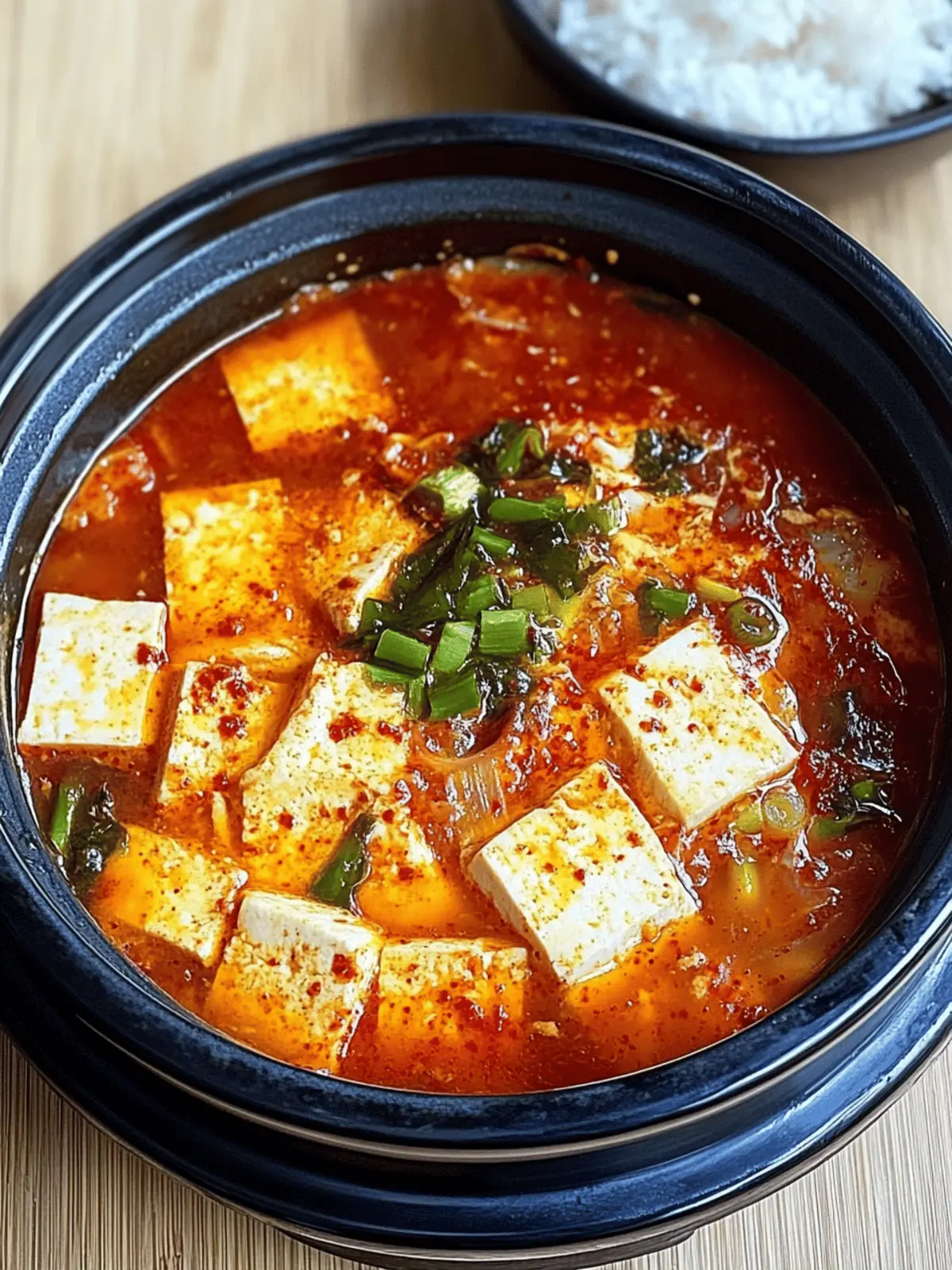
Korean Soft Tofu Stew: Comforting Warmth in Every Bite
Ingredients
Equipment
Method
- Heat sesame oil in a pot, then sauté the diced onion, sliced green onion, minced garlic, and red chili flakes for a minute.
- Add the pork belly and cook until browned, allowing flavors to meld.
- Pour in the broth, followed by soy sauce, salt, and pepper. Bring to a boil.
- Gently incorporate the silken tofu, breaking it into large chunks. Simmer on low for about 5 minutes.
- Crack an egg on top, garnish with green onions, and serve hot alongside steamed rice.

